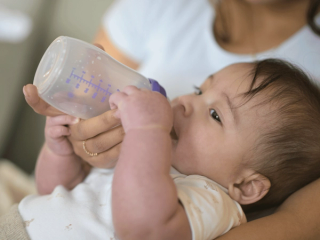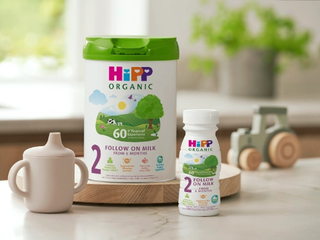
- Home
- Advice Hub
- Baby
- Baby Feeding
- Guide To Breastfeeding
The Essential Guide To Breastfeeding
Learn about the benefits of breastfeeding for both mum and baby, tips for getting started, and support options to help with common breastfeeding challenges.
Breastfeeding is one of the most natural and beneficial things you can do for your baby. The NHS recommends exclusive breastfeeding for the first six months of life. After that, giving your baby breast milk alongside solid foods for as long as you and your baby want will help them grow and develop healthily. (The WHO recommend up to 2 years of age).
Although breastfeeding may be natural, it's not always easy. Whether you're a first-time mum or an experienced one, being prepared, and having a good understanding of things that can help get you off to a good start are so important. That's why we've put together this essential guide to help you through your breastfeeding journey. From common mistakes to solutions, helpful techniques and support, read on to discover everything you need to know about breastfeeding for a comfortable and successful experience.
Benefits of breastfeeding
You may have already heard, breastfeeding has countless benefits for both you and your baby. If you’re still considering how you want to feed your baby, check out these great reasons to give breastfeeding a try. Below is a list of benefits for both you and your baby.
Benefits for baby:
- It provides them with antibodies that help protect them from infection.
- Breast milk is packed with everything your baby needs to thrive, including antibodies to boost their immature immune system, hormones to aid their development and proteins, fats, vitamins and minerals to help them grow.
- It can lower the risk of obesity and diabetes
- Reduced risk of sudden infant death syndrome (SIDS)
- Reduced risk of heart disease in adulthood
- Less likely to become unwell with diarrhoea and vomiting
- Breastmilk is responsive – it changes to meet the needs of your baby in that moment. For example, on a hot day, it will be more watery to keep your little one hydrated, while at night it includes more of the amino acid tryptophan, which helps your baby produce melatonin, a hormone which helps them feel sleepy.
Benefits for you:
- It helps the uterus shrink back quicker to pre pregnancy size
- Breastfeeding can lower the risk of certain female cancers such as breast and ovarian cancer later in life
- Cheap and convenient - One of the major benefits of breastfeeding is that you can feed your baby wherever and whenever you need to and it won’t cost you a penny.
- Lowers your risk of developing osteoporosis and cardiovascular disease.
Breastfeeding also helps promote bonding between mother and baby. When you breastfeed, your body produces lots of the love hormone oxytocin. This will lift your mood and help you feel calmer, happier and less stressed and will also help you bond with your newborn. Feeding your baby encourages you to spend time holding them, with plenty of skin-to-skin contact, which is really important for your little one’s social development, though of course this special time can also be achieved with bottle feeding.
You may also get a break from your period if you are exclusively breastfeeding. How long it will take to get your first period after giving birth will vary from woman to woman but for many new mums, they will go for several months or longer before their cycle starts again. This can be a good incentive if you usually suffer from painful periods. Some women find they don’t get a period until they stop breastfeeding, while others will start menstruating again once their baby starts going a bit longer in between feeds.
However, don’t be tempted to rely on breastfeeding as a contraceptive as you may well have started ovulating again without realising and it could result in an unexpected pregnancy.
Although breastfeeding is extremely beneficial for both you and your baby, it isn’t always easy.
Preparing for breastfeeding
Start preparing for breastfeeding during pregnancy
To get of to a good start with breastfeeding, you’ll have to start with yourself during pregnancy. Maintain a balanced diet and stay well-hydrated throughout the day to develop good benefits before your baby arrives. When breastfeeding, aim to drink about three litres of water daily. While this may seem like a lot, you might find yourself quite thirsty during this time! If you don’t have a particularly good diet, you might want to consider a pregnancy vitamin, and vitamin D is recommended throughout pregnancy.
Baby’s first milk: Colostrum
Colostrum is the first milk that starts to develop in the breasts sometime during the second trimester. It is thick in consistency and low in volume. You may or may not notice colostrum leaking during pregnancy. If you don’t, it’s totally normal. Colostrum is so low in volume that you’re unlikely to see any milk dripping. If you do notice anything, it’s more likely to be in the form of a yellow stain in your bra or a yellow crust on the end of your nipple.
Colostrum is the first milk that babies need, packed with nutrients to sustain them in the first few days of life. Around days 3-6, colostrum changes into a thinner, whiter milk called ‘full milk’.
If you are diabetic or have any factors which might limit your ability to breastfeed immediately from birth, consider colostrum harvesting. This involves collecting small droplets of colostrum in a sterile syringe and storing it in the freezer. It is then taking to the hospital when you give birth and fed to the baby if needed. It can be helpful for babies born to diabetic mothers that are having difficulty regulating blood sugars, or premature babies that are unable to latch to the breast.
Breastfeeding essentials
If you are planning on breastfeeding, you don’t necessarily need to buy a lot of items, however a good nipple cream and nipple pads may be useful. If you are planning on leaving your baby at some point to return to work or are away from your baby for any other reason, you might want to consider getting a breast pump. It may also be useful if you know that you will be having your baby prematurely. Premature babies benefit particularly from breastmilk as their guts are more prone to infection.
Do make sure you have access to the contact details for local infant feeding specialists and support groups so that you have them on hand if any problems arise during your feeding journey. Joining a breastfeeding class or course is always a great way to enhance your knowledge in preparation for feeding.
Breastfeeding positions
Breastfeeding can feel a bit awkward at first as you settle in to finding a position that suits you. Most people will begin by holding the baby in a cradle or cross cradle position in front of them. Women who have large breasts may find that an underarm position such as the ‘rugby hold’ works well for them. After a caesarean, side lying is generally a comfortable position for women. Your midwife will help you with positioning after the birth.
Getting your baby to latch
Aside from how you hold the baby, your baby getting a good latch onto the areola and nipple, is key. Many new mothers worry about whether or not they are doing it right and whether their baby is getting enough milk.
In order to ensure a successful and positive breastfeeding experience for both you and your baby, it is important to understand how the latch works. The latch is the connection between your baby's mouth and your breast. A good latch is key to preventing pain while breastfeeding, as well as ensuring that your baby gets enough milk.
To achieve a good latch, your baby should take as much of the areola (the darker area of skin around the nipple) into their mouth as possible, avoiding letting your baby suck on your nipple.
Once you have achieved a good latch, you will know it! There should be minimal pain and your baby should be able to stay on the breast without slipping off. If you are experiencing pain or your baby keeps slipping off, try repositioning them or using a different hold.
Once your baby is latched on, ensure that they have a good seal by checking that their lips are flanged outwards. You should also be able to hear them suckling rhythmically.
Here are some tips and tricks for getting the perfect latch:
- Start by positioning your baby's head close to your breast, with their chin touching your breast and their nose to your nipple.
- Ensure you and your baby are comfortable and in a position you're able to sustain. Feel free to kick out any visitors if you need to.
- Once their mouth is open wide, aim to get as much of your nipple and areola into their mouth as possible. You may need to hold them close to support them as they take a mouthful! You should hear them start to suckle at this point.
- If you experience any persistent pain or discomfort ensure you re-assess and re-latch. Do this as many time as you need to. It's important!
- To break the latch, simply insert your (clean) finger into the corner of your baby's mouth and they will release automatically.
The midwife who helps you when you give birth will assist you in getting a good latch. Don’t worry if it works well for the first feed and then not so well after that, it’s common to have bumps a long the way. Your midwife or maternity support worker on the ward will help you.
Breastfeeding can be a bit of a learning curve for both of you, but with a little patience and practice, you'll get the hang of it in no time.
Common issues with breastfeeding
If you experience any issues feeding your baby, seek support from your midwife, health visitor or a breastfeeding support worker. There are also breastfeeding helplines you can call for advice.
There are a few common issues that can arise when breastfeeding, but fortunately, there are also solutions for each one. You may need to get specialist help as this list isn't exhaustive and nothing beats in-person support. Here are some of the most common breastfeeding problems and how to fix them:
If your baby isn't latching on correctly, it can be painful for you and difficult for your baby to get enough milk. Make sure baby's chin is touching your breast, with the nose in line with the nipple. You can also try using a nipple shield to help continue breastfeeding if your nipples have become sore or cracked.
Babies often lose weight in the first few days after birth – typically less than 10%. Your midwife will weigh your baby to make sure they’re regaining this weight. Most babies return to or exceed their birth weight within the first two weeks. If your baby hasn’t regained their birth weight, or isn’t regaining it quickly enough, your midwife will be able to help you identify the problem and find a solution.
Engorgement happens when your breasts become overly full of milk. This can happen when you first start breastfeeding, as your milk is 'coming in', or if you miss a feed. To relieve engorgement, use a warm compress on your breasts or expressing some milk before feeding. This can also help to get your baby latched on well as the breast will be softer when it isn't so full.
Cracked nipples can be painful and make it difficult to breastfeed. To heal cracked nipples, you can use your own breastmilk or specific cream and make sure you're using a good nursing bra that provides support but isn't too tight. You may also want to avoid using soap or other lotions on your nipples while they're healing.
Thrush is a fungal infection caused by an overgrowth of candida, a yeast that naturally exists in the body but can multiply excessively under certain conditions, such as after antibiotic use or if the immune system is weakened.
For breastfeeding mothers, this can result in painful, itchy, or burning nipples, often accompanied by shiny, flaky, or cracked skin. In babies, thrush presents as white, curd-like patches inside the mouth or a persistent nappy rash. If thrush is suspected, it's important to seek treatment from a healthcare provider. Both you and baby will need to be treated simultaneously to prevent reinfection, often with antifungal medications.
Additionally, maintaining good hygiene, sterilising any breastfeeding equipment, and washing hands frequently can help manage and prevent thrush from worsening or recurring.
Breastfeeding can occasionally lead to blocked ducts, which happens when milk flow becomes obstructed in part of the breast. This can happen due to a variety of reasons, such as incomplete drainage of milk, pressure from tight clothing, skipping feedings, or poor latch.
A blocked duct often feels like a firm, tender lump in the breast, and the skin over the area may appear red and inflamed. Women may also experience localised pain and swelling. If a blocked duct is suspected, frequent breastfeeding or pumping to empty the breast is essential, as well as massaging the area and applying warm compresses to improve milk flow. In most cases, resolving the blockage early prevents complications, but if symptoms persist or worsen, seeking medical advice is important to prevent infection, like mastitis.
Mastitis is a painful and relatively common condition that can occur during breastfeeding when a milk duct becomes blocked. It subsequently causes inflammation in the breast.
Symptoms of mastitis include redness, swelling, warmth, and tenderness in the affected area, often accompanied by fever and flu-like symptoms. It may also present as a firm, sore lump in the breast. Treatment typically involves continuing to breastfeed or pump to keep milk flowing, applying warm compresses, rest, and in some cases, antibiotics to treat infection.
If mastitis is suspected, it's important to seek medical advice promptly to prevent complications such as abscess formation.
Combination feeding
Although breastfeeding provides optimal nutrition for your baby, there are times when it’s not possible or practical. If you can’t breastfeed, or you need to supplement your breastmilk with formula, you’re not a bad mother. You’re doing what’s best for you and your family, and that’s all that matters.
There are two ways to combine breastfeeding and formula feeding: combination feeding and pumping & bottle feeding.
Combination feeding: With combination feeding, you breastfeed your baby some of the time and supplement with formula at other times. This is a good option if you don’t want to commit to exclusively breastfeeding or pumping and bottle feeding.
Pumping and bottle feeding: With this method, you pump breastmilk and feed it to your baby from a bottle. This is a good option if you want to continue breastfeeding but need to be away from your baby or supplement with formula occasionally.
You can also visit the NHS’s Start4Life website, or contact one of the breastfeeding helplines for support with feeding:
National Childbirth Trust (NCT)
0300 330 0700
http://www.nct.org.uk/parenting/feeding
National Breastfeeding Helpline
08442 090 920 or 0300 100 0212
Webchat available at http://www.nationalbreastfeedinghelpline.org.uk/
La Leche
Breastfeeding Network
0300 100 0210
Frequently asked questions around breastfeeding
There are four stages of breastfeeding, starting with the colostrum phase. This occurs during late pregnancy and the first few days after birth. Colostrum is a thick, yellowish fluid rich in nutrients and antibodies that help protect the newborn from infections.
The second stage is the transitional milk phase, beginning around day three to five postpartum, when the milk volume increases and becomes creamier.
This is followed by the mature milk stage, typically starting around two weeks after birth, when the milk supply stabilises and contains a balance of foremilk, which is watery and quenches thirst, and hindmilk, which is fattier and satisfies hunger.
The final stage is the weaning phase, when breastfeeding gradually decreases as the baby begins to rely more on solid foods. Throughout these stages, the mother’s milk adjusts to meet the baby’s evolving nutritional needs.
As mentioned previously, this is the transitional phase and commonly occurs around 3 to five days postpartum. You may notice that the breasts become engorged and the milk make leak, so it’s important to have breast pads to hand.
To increase breast milk supply, it is important to ensure frequent and effective breastfeeding or pumping, as regular emptying of the breasts stimulates more milk production. Keeping the baby properly latched is crucial for efficient milk removal, which can be supported by working with a lactation consultant if needed. Staying hydrated and eating a balanced, nutritious diet can also help maintain a healthy milk supply. Skin-to-skin contact with the baby can encourage breastfeeding and enhance milk production. Additionally, reducing stress and getting enough rest, as much as possible, can positively influence milk supply. Certain herbal supplements like fenugreek or blessed thistle, as well as prescription medications, are sometimes used to increase supply, but it’s important to consult with a healthcare provider before trying these options.
A breastfed newborn feeds a lot. They should feed at least 8-12 times in any 24 hour period, and the times between each feed may vary. Sometimes it will be 1 hour, other times, 3 hours. Parents should practice responsive feeding – feeding your baby when they give you cues that they are hungry, even if they only fed a short time before.
Hunger signs include rooting, sucking on hands, or becoming fussy. Responsive feeding is recommended over a strict schedule. On average, a baby will feed every 2-3 hours round the clock. This tends to increase when they are going through a growth spurt. This frequent feeding is important because newborns have small stomachs and need to eat often to get enough nutrients. Frequent feeding in the early days helps establish your milk supply and ensures that the baby is getting enough nourishment for healthy growth and development.












